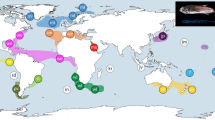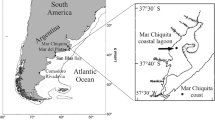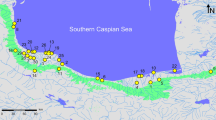Abstract
Gaidropsarus Rafinesque, 1810 is a genus of marine teleost characterized by a high ecological diversity and by species inhabiting from the intertidal zone to the deep-sea. Several taxonomic conundrums have been historically present in this taxon due to its conservative morphology and the lack of available specimens. Species delimitation analyses were carried out in multiple datasets combining both mitochondrial (COI, CytB, ND2) and nuclear (Rho, ZIC1) genetic markers. Despite some incongruence between mitochondrial and nuclear data, the analyses supported the synonymy between Gaidropsarus biscayensis and Gaidropsarus macrophthalmus and the molecular confirmation of a recently new described species Gaidropsarus gallaeciae, in the North Atlantic Ocean. Furthermore, recent speciation events can explain the close relationships among several Gaidropsarus species, including Gaidropsarus granti–Gaidropsarus vulgaris and Gaidropsarus argentatus–Gaidropsarus ensis. These results support previous findings highlighted through DNA Barcoding analyses. Incongruences between mtDNA and nDNA have arisen between Gaidropsarus guttatus and Gaidropsarus mediterraneus, therefore, further analyses will be necessary to unravel the phenomena related to them.


Similar content being viewed by others
Data availability
Molecular data generated during this study consisted of sequences belonging to three mitochondrial (COI; Cytb; ND2) and two nuclear (Rho and ZIC1) markers. All these sequences are deposited in GenBank; all GenBank accession numbers used in are listed in Table 1.
References
Akaike H (1973) Information theory and an extension of the maximum likelihood principle. In: Petrov BN and Caski F (eds) Proceedings of the second international symposium on information theory. Akademiai Kiado, Budapest, p 267–281
Balushkin AV (2009) On the first occurrence of the rockling Gaidropsarus pakhorukovi Shcherbachev (Gairdropsarini, Lotidae, Gadidae) and on species diagnostics of G. pakhorukovi and G. parini Svetovidov. Jpn J Ichthyol. https://doi.org/10.1134/S0032945209090033
Bañón R, Arronte JC, Vázquez-Dorado S, Del Río JL, De Carlos A (2013) DNA barcoding of the genus Lepidion (Gadiformes: Moridae) with recognition of Lepidion eques as a junior synonym of Lepidion lepidion. Mol Ecol Resour. https://doi.org/10.1111/1755-0998.12045
Bañón R, de Carlos A, Ruiz-Pico S, Baldó F (2020) Unexpected deep-sea fish species on the Porcupine Bank (NE Atlantic): biogeographical implications. J Fish Biol. https://doi.org/10.1111/jfb.14418
Bañón R, De Carlos A, Farias C, Vilas-Arrondo N, Baldó F (2021) Exploring deep-sea biodiversity in the Porcupine Bank (NE Atlantic) through fish integrative taxonomy. J Mar Sci Eng. https://doi.org/10.3390/jmse9101075
Bañón R, Baldó F, Serrano A, Barros-García D, de Carlos A (2022) Gaidropsarus gallaeciae (Gadiformes: Gaidropsaridae), a New Northeast Atlantic rockling fish, with commentary on the taxonomy of the genus. Biology. https://doi.org/10.3390/biology11060860
Barros-García D, Bañón R, Arronte JC, De Carlos A (2016) New data reinforcing the taxonomic status of Lepidion eques as synonym of Lepidion lepidion (Teleostei, Gadiformes). Biochem Syst Ecol. https://doi.org/10.1016/j.bse.2016.06.017
Barros-García D, Bañón R, Arronte JC, Fernández-Peralta L, García R, Iglésias SP, Sellos YD, Barreiros PJ, Comesaña AS, De Carlos A (2018) New insights into the systematics of North Atlantic Gaidropsarus (Gadiformes, Gadidae): flagging synonymies and hidden diversity. Mar Biol Res. https://doi.org/10.1080/17451000.2017.1367403
Biscoito M, Saldanha L (2018) Gaidropsarus mauli a new species of three-bearded rockling (Gadiformes, Gadidae) from the Lucky Strike hydrothermal vent field (Mid-Atlantic Ridge) and the Biscay Slope (Northeastern Atlantic). Zootaxa. https://doi.org/10.11646/zootaxa.4459.2.5
Bouckaert R, Vaughan TG, Barido-Sottani J, Duchêne S, Fourment M, Gavryushkina A et al (2019) BEAST 2.5: an advanced software platform for Bayesian evolutionary analysis. PLoS Comput Biol. https://doi.org/10.1371/journal.pcbi.1006650
Brown WM, George M, Wilson AC (1979) Rapid evolution of animal mitochondrial DNA. Proc Natl Acad Sci USA. https://doi.org/10.1073/pnas.76.4.1967
Cohen DM, Russo JL (1979) Variation in the four beard rockling, Enchelyopus cimbrius, a North Atlantic gadid fish, with comments on the genera of rocklings. US Natl Mar Fish Serv Fish Bull 77:91–104
Cohen DM, Inada T, Iwamoto T, Scialabba N (1990) FAO species catalogue. Gadiform fishes of the world (order Gadiformes). An annotated and illustrated catalogue of cods, hakes, grenadiers and other gadiform fishes known to date. FAO Fish Synop 125:1–442
da Silva R, Peloso PLV, Sturaro MJ, Veneza I, Sampaio I, Schneider H, Gomes G (2018) Comparative analyses of species delimitation methods with molecular data in snappers (Perciformes: Lutjaninae). Mitochondrial DNA. https://doi.org/10.1080/24701394.2017.1413364
Darriba D, Taboada GL, Doallo R, Posada D (2012) jModelTest 2: more models, new heuristics and parallel computing. Nat Methods. https://doi.org/10.1038/nmeth.2109
Dayrat B (2005) Towards integrative taxonomy. Biol J Linn Soc. https://doi.org/10.1111/j.1095-8312.2005.00503.x
De Queiroz K (2007) Species concepts and species delimitation. Syst Biol. https://doi.org/10.1080/10635150701701083
Dvořák T, Šlechtová V, Bohlen J (2022) Using species groups to approach the large and taxonomically unresolved freshwater fish family Nemacheilidae (Teleostei: Cypriniformes). Biology. https://doi.org/10.3390/biology11020175
Francisco SM, Robalo JI, Stefanni S, Levy A, Almada VC (2014) Gaidropsarus (Gadidae, Teleostei) of the North Atlantic Ocean: a brief phylogenetic review: phylogeny of Gaidropsarus in the North Atlantic. J Fish Biol. https://doi.org/10.1111/jfb.12437
Froese R, Pauly D (2020) Fishbase. World wide web electronic publication. www.fishbase.org, Version February 2022
Fujita MK, Leaché AD, Burbrink FT, McGuire JA, Moritz C (2012) Coalescent-based species delimitation in an integrative taxonomy. Trends Ecol Evol. https://doi.org/10.1016/j.tree.2012.04.012
Harrison RG, Larson EL (2014) Hybridization, introgression, and the nature of species boundaries. J Hered. https://doi.org/10.1093/jhered/esu033
Hebert PDN, Cywinska A, Ball SL, deWaard JR (2003) Biological identifications through DNA barcodes. Proc R Soc Lond B Biol. https://doi.org/10.1098/rspb.2002.2218
Hebert PDN, Stoeckle MY, Zemlak TS, Francis CM (2004) Identification of birds through DNA barcodes. PLoS Biol. https://doi.org/10.1371/journal.pbio.0020312
Ivanova NV, Zemlak TS, Hanner RH, Hebert PDN (2007) Universal primer cocktails for fish DNA barcoding. Mol Ecol Notes. https://doi.org/10.1111/j.1471-8286.2007.01748.x
Iwamoto T, Cohen DM (2016) Gaidropsaridae. In: Carpenter KE, de Angelis N (eds) The living marine resources of the eastern Central Atlantic. Bony fishes. Part 1 (Elopiformes to Scorpaeniformes), vol 3. FAO, Rome, pp 2015–2022
Janko K, Marshall C, Musilova Z, Van Houdt J, Couloux A, Cruaud C, Lecointre G (2011) Multilocus analyses of an Antarctic fish species flock (Teleostei, Notothenioidei, Trematominae): phylogenetic approach and test of the early-radiation event. Mol Phylogenet Evol. https://doi.org/10.1016/j.ympev.2011.03.008
Kapli P, Lutteropp S, Zhang J, Kobert K, Pavlidis P, Stamakis A, Flouri T (2017) Multi-rate poisson tree processes for single-locus species delimitation under maximum likelihood and Markov Chain Monte Carlo. Bioinformatics. https://doi.org/10.1093/bioinformatics/btx025
Kornilios P, Jablonski D, Sadek RA, Kumlutas Y, Olgun K, Avci A, Ilgaz C (2020) Multilocus species-delimitation in the Xerotyphlops vermicularis (Reptilia: Typhlopidae) species complex. Mol Phylogenet Evol. https://doi.org/10.1016/j.ympev.2020.106922
Krishnamurthy PK, Francis RA (2012) A critical review on the utility of DNA barcoding in biodiversity conservation. Biodivers Conserv. https://doi.org/10.1007/s10531-012-0306-2
Lanfear R, Frandsen PB, Wright AM, Senfeld T, Calcott B (2016) PartitionFinder 2: new methods for selecting partitioned models of evolution for molecular and morphological phylogenetic analyses. Mol Biol Evol. https://doi.org/10.1093/molbev/msw260
Messing J (1982) New M13 vectors for cloning. Method Enzymol. https://doi.org/10.1016/0076-6879(83)01005-8
Miller MA, Pfeiffer W, Schwartz T (2010) Creating the CIPRES Science Gateway for inference of large phylogenetic trees. In: Proceedings of the gateway computing environments workshop (GCE), New Orleans, LA. p 1–8. Nov 2010
Monaghan MT, Wild R, Elliot M, Fujisawa T, Balke M, Inward DJG, Lees DC, Ranaivosolo R, Eggleton P, Barraclough TG, Vogler AP (2009) Accelerated species inventory on madagascar using coalescent-based models of species delineation. Syst Biol. https://doi.org/10.1093/sysbio/syp027
Nelson JS, Grande TC, Wilson MVH (2016) Fishes of the world, 5th edn. John Wiley and Sons, Hoboken
Pons J, Barraclough TG, Gomez-Zurita J, Cardoso A, Duran DP, Hazell S, Kamoun S, Sumlin WD, Volger AP (2006) Sequence-based species delimitation for the DNA taxonomy of undescribed insects. Syst Biol. https://doi.org/10.1080/10635150600852011
Puillandre N, Lambert A, Brouillet S, Achaz G (2012) ABGD, automatic barcode gap discovery for primary species delimitation. Mol Ecol. https://doi.org/10.1111/j.1365-294X.2011.05239.x
Rambaut A, Drummond AJ, Xie D, Baele G, Suchard MA (2018) Posterior summarization in Bayesian phylogenetics using tracer 1.7. Syst Biol. https://doi.org/10.1093/sysbio/syy032
Roa-Varón A, Dikow RB, Carnevale G, Tornabene L, Baldwin CC, Li C, Hilton EJ (2020) Confronting sources of systematic error to resolve historically contentious relationships: a case study using gadiform fishes (Teleostei, Paracanthopterygii, Gadiformes). Syst Biol. https://doi.org/10.1093/sysbio/syaa095
Sevilla RG, Diez A, Norén M, Mouchel O, Jérôme M, Verrez-bagnis V, Van Pelt H, Favre-Krey L, Krey G, Bautista JM (2007) Primers and polymerase chain reaction conditions for DNA barcoding teleost fish based on the mitochondrial cytochrome b and nuclear rhodopsin genes. Mol Ecol Notes. https://doi.org/10.1111/j.1471-8286.2007.01863.x
Shcherbachev YN (1995) New species of rockling, Gaidropsarus pakhorukovi (Gadidae), from the Rio Grande Rise (Southwest Atlantic). Jpn J Ichthyol. https://doi.org/10.1134/S0032945209090033
Svetovidov AN (1986a) Review of three-bearded rocklings of the genus Gaidropsarus Rafinesque, 1810 (Gadidae) with description of a new species. Jpn J Ichthyol. https://doi.org/10.1134/S0032945209090033
Svetovidov AN (1986b) Gadidae. In: Whitehead PJP, Bauchot ML, Hureau JC, Nielsen J, Tortonese E (eds) Fishes of the North-Eastern Atlantic and the Mediterranean, vol 2. UNESCO, Paris, pp 680–710
Tan D, Parus A, Dunbar M, Espeland M, Willmot KR (2021) Cytochrome c oxidase subunit I barcode species delineation methods imply critically underestimated diversity in “common” Hermeuptychia butterflies (Lepidoptera: Nymphalidae: Satyrinae). Zool J Linn Soc Lond. https://doi.org/10.1093/zoolinnean/zlab007
Tang CQ, Humphreys AM, Fontaneto D, Barraclough TG (2014) Effects of phylogenetic reconstruction method on the robustness of species delimitation using single-locus data. Methods Ecol Evol. https://doi.org/10.1111/2041-210X.12246
Torres-Hernández E, Betancourt-Resendes I, Angulo A, Robertson DR, Barraza E, Espinoza E, Díaz-Jaimes P, Domínguez-Domínguez O (2022) A multi-locus approach to elucidating the evolutionary history of the clingfish Tomicodon petersii (Gobiesocidae) in the Tropical Eastern Pacific. Mol Phylogenet Evol. https://doi.org/10.1016/j.ympev.2021.107316
Vitecek S, Kučinić M, Previšić A, Živić I, Stojanović K, Keresztes L, Bálint M, Hoppeler F, Waringer F, Graf W, Pauls SU (2017) Integrative taxonomy by molecular species delimitation: multi-locus data corroborate a new species of Balkan Drusinae micro-endemics. BMC Evol Biol. https://doi.org/10.1186/s12862-017-0972-5
Ward RD, Zemlak TS, Innes BH, Last PR, Hebert PDN (2005) DNA barcoding Australia’s fish species. Philos Trans R Soc Lond B Biol. https://doi.org/10.1098/rstb.2005.1716
Zhang J, Kapli P, Pavlidis P, Stamakis A (2013) A general species delimitation method with applications to phylogenetic placements. Bioinformatics. https://doi.org/10.1093/bioinformatics/btt499
Acknowledgements
This research was supported by national funds by FCT-Foundation for Science and Technology through the projects UIDB/04423/2020 and UIDP/04423/2020. FCT also supported DBG (DBG 2020.04364.CEECIND) and EF (CEECIND/00627/2017). The authors acknowledge the support and the use of resources of EMBRC-ERIC, specifically of the Portuguese infrastructure node of the European Marine Biological Resource Centre (EMBRC-PT) CIIMAR—PINFRA/22121/2016—ALG-01-0145-FEDER-022121, financed by the European Regional Development Fund (ERDF) through COMPETE2020—Operational Programme for Competitiveness and Internationalization (POCI) and national funds through FCT/MCTES. The authors would like to thank the staff involved in the following research surveys of the ‘Instituto Español de Oceanografía (IEO-CSIC)’: FLEMISH 2015, INDEMARES-BANGAL 0811, FLETÁN ÁRTICO 2015 (Project ECOPESLE) and PORCUPINE 2019. We also extend our thanks to the crews of the Research Vessels ‘Miguel Oliver’ and ‘Vizconde de Eza’ (Ministry of Agriculture, Food and Environment, Spain). Alberto Serrano (IEO-CSIC) is especially recognized. The IEO research surveys have been funded by the European Union through the European Maritime and Fisheries Fund (EMFF) within the National Program of collection, management and use of data in the fisheries sector and support for scientific advice regarding the Common Fisheries Policy. Thanks are due to João Medeiros for his help in providing specimens from the Azores.
Author information
Authors and Affiliations
Contributions
FB and JCA obtained the samples during oceanographic surveys. ASC was in charge of the laboratory protocols; DNA extraction, PCR and sequencing. DBG carried out the bioinformatic analyses. RB, DBG, AC and EF contributed to the study conception and design. The first draft of the manuscript was written by DBG and all authors commented on previous versions of the manuscript. All authors read and approved the final manuscript.
Corresponding author
Ethics declarations
Conflict of interest
The authors have no conflict of interest to declare that are relevant to the content of this article.
Ethical approval
The samples used in this study were obtained within the framework of the annual oceanographic campaigns carried out by the Spanish Institute of Oceanography in various locations in the North Atlantic and the Mediterranean Sea following the established protocols. No species of Gaidropsarus is listed in the IUCN red list as critically endangered, endangered, vulnerable, or near-threatened species.
Consent to participate
All authors gave consent to participate.
Consent for publication
All authors consent to the submission and publication of this article upon acceptance.
Additional information
Responsible Editor: O. Puebla.
Publisher's Note
Springer Nature remains neutral with regard to jurisdictional claims in published maps and institutional affiliations.
Supplementary Information
Below is the link to the electronic supplementary material.
Rights and permissions
Springer Nature or its licensor holds exclusive rights to this article under a publishing agreement with the author(s) or other rightsholder(s); author self-archiving of the accepted manuscript version of this article is solely governed by the terms of such publishing agreement and applicable law.
About this article
Cite this article
Barros-García, D., Comesaña, Á.S., Bañón, R. et al. Multilocus species delimitation analyses show junior synonyms and deep-sea unknown species of genus Gaidropsarus (Teleostei: Gadiformes) in the North Atlantic/Mediterranean Sea area. Mar Biol 169, 131 (2022). https://doi.org/10.1007/s00227-022-04118-8
Received:
Accepted:
Published:
DOI: https://doi.org/10.1007/s00227-022-04118-8




